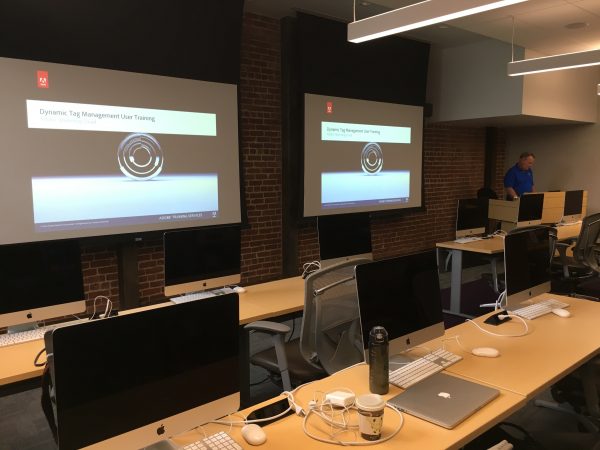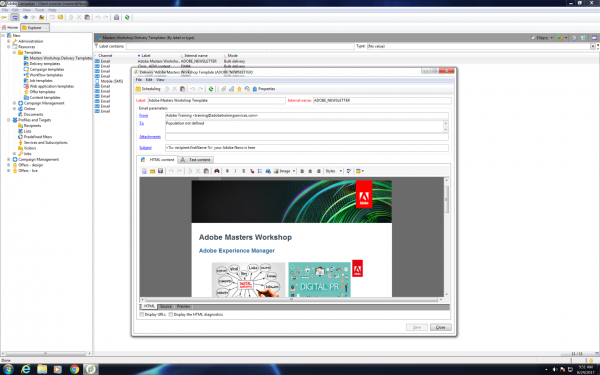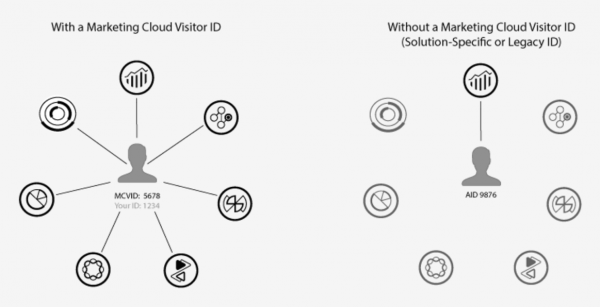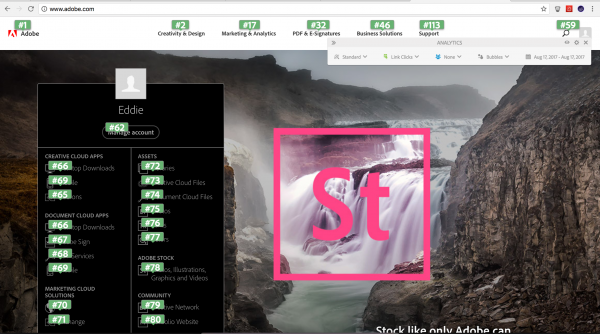I had the opportunity to attend the first-ever Adobe Digital Marketing Masters Workshop in the Adobe office in San Francisco last week. The 5-day in-classroom workshop was packed with knowledge and hands-on information about some of the most popular Adobe Experience Cloud products, including Adobe Experience Manager, Adobe Campaign, Adobe Target, Adobe Analytics, Dynamic Tag Management, and Adobe Audience Manager.
It expanded my knowledge base on Adobe Experience Cloud products, connected the dots for me and gave me a more holistic view of Adobe’s marketing solutions. It was also a great opportunity to network with Adobe and different companies that are using Adobe solutions.
Here are 10 takeaways from the workshop:


(training room in Adobe SF office) (touch screen in cafeteria is built with AEM screen – so cool)
1. Make Experience Your Business
This is a high-level, one-sentence business goal the Adobe Experience Cloud can achieve for enterprise. Customers engage with the brand throughout the customer journey; they may not remember how they are contacted by the brand, but they remember if their experience with the brand is good or bad. A good experience consists of compelling and personalized experiences, timely analytics context to understand the customer, prediction of customer needs, consistent experience across touchpoints and continuous measurement and optimization of customer experience.

2. Know What Each Product Does at A High Level Inside Experience Cloud
Adobe Experience Manager (AEM): content, digital assets, experience creation, manage and delivery engine
Adobe Campaign: cross-channel (email, newsletters, SMS, direct mail, prints, online, offline, real-time remarketing) campaign management tool
Adobe Target: A/B or multi variant testing and prediction engine to see what drives more traffic and what gets more conversion etc. then personalize content based on audience
Adobe Analytics: robust reports and data analysis engine across marketing channels
Dynamic Tag Management (DTM): manage both Adobe and third-party tags, provide and send necessary data for Adobe Analytics, Target… to consume
Adobe Audience Manager (AAM): manage and create audience to be used in multiple platforms
3. AEM: Know the Difference Between Content Fragment and Experience Fragment
Content fragment: text and mixed media, import text from file
Experience fragment: like a mini page, is created from a template, can drag and drop components (including content fragment), use layout mode, etc.
4. Adobe Campaign to Sync With AEM, AAM, CRM, Analytics and More
Adobe Campaign standard (new) or Campaign 6.1 – 7 can be integrated with AEM. For example, you can create an email template in AEM with built components and approved images, and then sync the template content in Campaign so you can manage and send them out to your campaign audience list. Campaign has its own database, but you can use and connect with a data warehouse. It uses a lot of workflows (called technical workflow) to connect with various datasources, CRM, process data and perform operations on a regular basis. Also, Campaign can bring audience from AAM (it uses reconciliation key to map user id from AAM). Moreover, with Marketing Cloud Triggers, marketers can listen to shopping cart abandonment, incomplete forms, etc., and trigger ‘real-time’ re-marketing campaign to the targeted audience when such events happen. This can be an integrated solution with Adobe Analytics, Campaign and Target.

5. Keep the Adobe Product in Context When You Talk About a Term
Same term can be different things, same thing can be different terms in Adobe Experience Cloud solutions. I think Adobe can use some clean up and unification on the terminology across the board. For example, there are reports in all AEM, Target, Analytics, Campaign, but apparently they are used for different purposes; you can create and export (share) audience in Target, Audience Manager, Analytics, AEM and Campaign, but it’s called segments in Analytics, audience in Target, and recipient list in Campaign; visitor in Target is different from visitor in Analytics etc.
visitor in Analytics: visitor who enters the site
visitor in Target: visitor who enters the activity
6. Plan for Your Test and Analytics Report Strategically
Strategic planning for creating Adobe Target activities and Adobe Analytics metrics, reports is critical for a success in the Adobe Experience Cloud implementation and driving your business the correct direction. If you don’t set Target activities correctly, you may end up having multiple overlapping activities for a user and you don’t know what happen; if you don’t understand different metrics and segments in Analytics, you can end up misinterpreting an Analytics report.
Target for testing:
Multi-variant testing is for multiple elements (multiple components) on the page, but that’s usually complicated and involved multiple factors, you can start from A/B testing on single element first (like banner image).
Reference to Plan Your A/B Test section in Adobe Target Product Documentation.
One activity on one area of page at a time, otherwise activities will overlap (check collisions if that happens).
Set up audiences report filter in A/B testing activity, so you can get more insights from the test report based on audience subgroup.
Analytics for reporting:
Analytics run report for Key Performance Indicators (KPIs) that is tactical and to indicate if company is achieving Key Business Requirements (KBRs). Iterate these five steps recursively for a better analytics result:
- Understand KBRs, and then define KPIs
- Report
- Analyze
- Optimize
- Innovate
7. Adobe Target and Adobe Analytics: Know the Basic Code Implementation on the Page
Both Adobe Target and Adobe Analytics use JavaScript to implement on the page. You can use DTM (satellite js, placed in header and footer) to provide and send data to Adobe Target and Adobe Analytics. And to implement Target and Analytics specifically:
Target code on top of the page: At.js
This new implementation library for Adobe Target executes mbox (marketing box) calls asynchronously through XMLHttpRequest, and does not block page rendering, time saver. Mbox is used by Target to display personalized content and log visitor behavior. There can be two types of mbox on a page, global mbox and regional mbox. Global mbox is at the top of page and can manipulate content in the whole page, whereas regional mbox is wrapped around one div element and can change only that element.
Analytics code on bottom of the page: AppMeasurement.js and VisitorAPI.js
(references: https://marketing.adobe.com/resources/help/en_US/target/ov2/c_target-atjs-implementation.html
https://marketing.adobe.com/resources/help/en_US/tnt/help/c_Mboxes.html
https://marketing.adobe.com/resources/help/en_US/target/ov/c_understanding-global-mbox.html
https://marketing.adobe.com/resources/help/en_US/sc/implement/js_implementation.html)
8. Marketing Cloud Core Services: MCVID
Before, a site visitor cannot be unanimously identified by different Adobe solutions because each of them have their own database. This can be resolved by the new Marketing Cloud Visitor ID (MCVID). Marketing Cloud Visitor ID is provided by marketing cloud core services, it uses a separate database and is used by Adobe Target, Analytics and other solutions to match up visitor data.

(references: https://marketing.adobe.com/resources/help/en_US/mcvid/mcvid-overview.html)
9. These Are the Tools and Places That Will Help You Develop, Debug and Learn
Adobe debugger: tool to view data being collected from web page (choose option from dropdown to perform an action or set a mode, i.e. choose deleteCookies to remove browser cookies and refresh page).
NEW – Experience Cloud Debugger for Chrome: a Chrome browser extension and debugger for Adobe Experience Cloud solutions including Adobe Analytics, Adobe Target, Adobe Audience Manager, Adobe Media Optimizer, Adobe Marketing Cloud Visitor Service, and DTM.
Launch activity map: a browser plugin to display link rankings and real-time (live) page analytics.

mboxTrace: a query parameter you can set to debug and trace profile information for Adobe Target.
“mbox|b/ss|demdex”: a regex search to filter the Network calls to those made by Target, Analytics or Audience Manager.
Sample Size Calculator: a tool for Adobe Target to determine an adequate sample size (number of visitors) prior to doing any A/B test, in order to establish the time that the test should be allowed to run before evaluating the results.
YouTube channels: tutorial videos and demos on new feature, updated frequently, especially for Adobe Analytics, Adobe Target, Adobe Experience Cloud Core Services. You can just do a simple search for other products and see.
Help pages: very useful and informative help pages for Adobe Experience Cloud, use search liberally for keyword and your questions.
10. These Are the New Technology and Trending Features in Adobe Experience Cloud
Adobe Launch, the new and next generation of dynamic tag management, is coming out in the fall, and will replace DTM (both are separate products and will be supported)
Adobe Analytics analysis workspace to replace ad hoc analysis (depth and speed) and report suite, report builder (speed, some depth, data is normalized)
At.js replaces mbox.js for Target implementations. The at.js library also includes the components that were included in target.js, so there is no longer a call to target.js. You cannot use both mbox.js and at.js on a single page.
Random Forest Algorithm: AI auto targeting based on audience
In conclusion, each product inside the Adobe Experience Cloud family is robust and can be integrated (at some level). There are many possibilities that each product can provide standalone or together. Consult with your Adobe business partners and plan for your digital marketing transformation so you can orchestrate your customer experience with the most of Adobe Experience Cloud products.

Thanks for sharing, it was informative. We play a small role in upskilling people providing the latest tech courses. Join us to upgradeADOBE TARGET ONLINE TRAINING